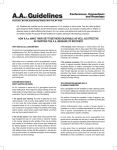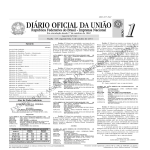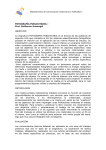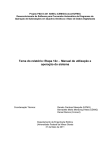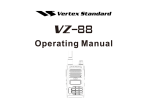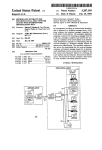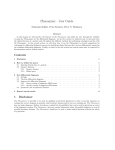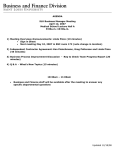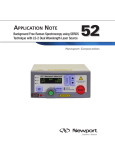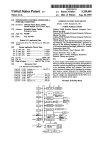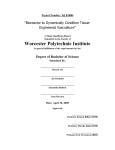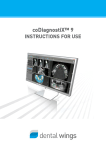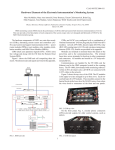Download Code controlled microcontroller readout from coin operated machine
Transcript
United States Patent [19]
[11]
4,216,461
Werth et al.
[45]
Aug. 5, 1980
vol. 49 No. 19, pp. 16E, 18E, Sep. 16, 1976 (Reproduced
by Patent Associated Literature).
[54] CODE CONTROLLED
MICROCONTROLLER READOUT FROM
COIN OPERATED MACHINE
[76] Inventors: Robert L. Werth, 2053 W. Romneya
Dr., Anaheim, Calif. 92801; Timothy
L. Brehm, 27 Golden Star, Irvine,
Calif. 92714
[51]
[58]
ABSTRACT
microprocessor controlled portable collection unit
(PCU) are provided for monitoring vending machine
Sep.6,1977
Int. C1.2 ..................... .. G08B 25/00; H04Q 9/00;
G06K 5/02; G06F 7/00
[52]
[57]
A coin counter attached to a vending machine and a
[21] Appl. No.: 830,758
[22] Filed;
Primary Examiner-Donald J. Yusko
Attorney, Agent, or Firm—Willie Krawitz
US. Cl. ................ .i ...... .. 340/149 R; 235/92 CN;
operations. This enables transactions of the machine to
be calculated, stored and recorded. The coin counter
forms part of a microelectronic circuit (e.g. a MOS
273/143 R; 340/150; 340/162; 364/479; 194/1
type) and is attached or mounted as a package to the
Field of Search ............. .. 340/149 R, 147 A, 152,
count net coin intake but can be programmed to provide
340/151, 150, 162; 364/403, 406, 479; 235/92
other information such as coin collection times, vending
machine number, code validations, etc.
The PCU has a keyboard to input information to the
AC, 92 CN, 92 ST, 92 RD; 273/138 A, 139,
143; 194/1 N
References Cited
U.S. PATENT DOCUMENTS
[56]
3,786,421
l/ 1974
Wostl et a1. ................... .. 340/147 A
3,894,220
7/1975
Levasseur
3,931,497
4,072,930
l/ 1976
2/ 1978
Gentile et al.
Lucero et al.
. .... .. ..
. . . . . ..
364/479
4,075,463
2/ 1978
Eguizabal .
4,086,434
4/1978
Bocchi ............................... .. 340/151
340/149 A
340/152 T
364/479
vending machine. The counter is primarily designed to
counter and access information therefrom; the PCU
calculates the coin count value and displays this value
and the other information on an LED, printer, etc.,
upon input of a suitable access code.
The PCU may be employed for servicing a number of
vending machines to better pinpoint responsibility for
collection de?ciencies, determining location and ma.
chine effectiveness, peak load times, and so forth. The
information so obtained can be maintained secret within
OTHER PUBLICATIONS
“Computerized Automatic Pumping System”, L. L.
Pelletier IBM Technical Disclosure Bulletin, vol. 14, No.
10 May 1972, pp. 3729-373l.
the PCU itself and can be accessed only upon the input
of the correct code.
i
18 Claims, 6 Drawing Figures
“Inventory Unit is Tiny Data Terminal” Electronics,
9
j
COIN
INPUT
'6 \
[I]
/ I?
,8
E!
l9
at?
Q;
[31]
:§ I
OWNER NUMBER
1
[El
COIN
RETURN
1:1\ / [:3 MW,
I
22
NUMBER
ALARMS
COIN
SENSING
NM
_
COIN INPUT
I
20
PROCESSOR UNIT 4
TIME FUNCTION
.
SERVICE
ALARM
SERWCE
miss“
2|
Pow ER
/
OUTPUT
ALARM
INTERROGATION
COMMAND
an
CLOCK
RESET COMMAND
23
COIN COUNTER
IO
/
—
US. Patent
Aug. 5, 1980
Sheet 1 of6
20-76m29;
4,216,461
024 0 P02m4w0
m:ow23m
mm
N
4
2
4
4. m m2; x0 40
$5382
U.S. Patent
Aug. 5, 1980
Sheet 4 of6
4,216,461
P9.m3m
P94m m
/
.0E4w1mE
QMmt
$5.60EDMFZ (ME
>
2»
/2
E5m i 93¢
4,216,461
1
CODE CONTROLLED MICROCONTROLLER
READOUT FROM COIN OPERATED MACHINE
BACKGROUND OF THE INVENTION
This invention relates to a new and improved system
for coin counting, totalling and reading-out information
arising from coin transactions in vending machines and
the like. More speci?cally, this invention concerns the
use of single chip microelectronic circuits for'counting
the net coin intake of a vending machine, storing the
count and reading it out to a microprocessor controlled
portable collection unit (PCU). The coin counter may
be wired, permanently attached or integrated with the
vending machine and is considerably less costly than
the vending machine itself. The PCU is used to calcu
late a money total from the coin count and, if desired,
2
edge in itself represents a deterrent to interfering with
normal operations of the vending machine. In any
event, if a shortage exists, use of a counter which is
accurate and tamper resistant permits the owner to
5 establish the extent of his losses which serve as a legiti
mate basis for a tax loss claim.
THE INVENTION
According to the invention, a tamper resistant system
for coin counting and totalling net intake of vending
machines is provided comprising a sensing and counting
device employing a microelectronic circuit chip having
a plurality of memory registers. The counting device is
attached or incorporated with the vending machine and
is adapted to sense and count net coin intake (after coin
changing) and store the net count and other related
operations in a plurality of memory registers in the
display or output certain other operations associated
with the vending machine. The PCU is employed to
service a large number of vending machines, and al
though considerably more expensive than the counter,
power interruptions, vending load times, tampering,
‘since its use is spread over a large number of vending
etc.
microelectronic circuits. These related operations may
include an access code which is unique to the machine
(and hence the owner), coin collection dates and times,
‘machines, its unit cost is relatively low.
A PCU is provided having an input keyboard to
Vending machines in the broad sense provide a ?xed
access the memories upon input of a valid access code.
service for a speci?c price and include such varied 25 The output from the memories of the coin counter is
devices as games, laundromat equipment, food dispens~
added in the PCU to obtain a money value which may
ers, music players, cigarette vending machines, photo
graphic equipment, television sets and other coin oper
ated devices.
‘
The vending machines must be serviced for coin
collections, change replenishment, service replenish
them such as food, soap, photographic ?lm, etc. Also, in
the case of vending machines such as games, music
players, etc., the owner would like to have information
be read out from the PCU on a display such as an LED,
LCD, incandescent, etc., or onto a printer, casette,
punched card, teletype, etc; the other related operations
are similarly read out. The PCU also may be adapted to
store the read-outs and display them only upon receipt
of a second access code. This permits the owner, lessee,
etc., to enjoy total secrecy from the person (akin to the
on whether the income from the vending machine is
meter reader) who actually obtains the information
jammed. Even assuming the accuracy of a coin counter,
an access key to a vending machine can be duplicated
FIG. 1 is a block diagram showing the overall view
of the counter and PCU arrangement of this invention;
FIG. 2 shows a block diagram of the PCU; and,
FIGS. 3A, 38, 4A, 4B show two programs employed
for the operation of the counter and PCU.
from the coin counter. This arrangement ensures a dou
adequate for its location and also optimum servicing
ble check on the secrecy of the contents in the coin
times. When a machine is serviced, access must be ob
counter, if desired, since a ?rst access code is required
tained to the interior of the machine and this involves
to read-out the information from the coin counter and a
the honesty of the coin collector, part owner, lessee,
proprietor, etc., where the vending machine is located. 40 second access code is needed to read-out the informa
tion from the PCU. The coin counter should contain the
If these people are dishonest, even a small amount of
fewest number of operating functions on a cost basis,
“skimming” can, over a period of time, amount to a
and hence, a register for validating the codes is con
substantial income loss.
tained preferably within the PCU.
Devices are presently on the market which total coin
counts and obtain a dollar value therefrom; however, 45
BRIEF DESCRIPTION OF THE DRAWINGS
they are not tamper resistant and can be physically
and this poses additional problems.
Hence, acheck on income, servicing requirements,
performance, etc., is desireable from many standpoints.
Furthermore, as between competitive devices and their
locations, secrecy is important since the most suitable
DESCRIPTION OF THE PREFERRED
EMBODIMENT
machine in an optimum location can spell the difference
The overall system is shown in FIG. 1 and includes a
between a successful or a defunct business. Also, cus 55
vending machine 9 and a coin counter 10 including the
tomer preference _for game ‘machines can change
usual coin sensing circuits 11. A portable PCU 12 is
quickly and this may necessitate a machine being re
provided to interrogate the counter 10 and obtain infor
moved to a new location or being taken completely off
mation stored therein concerning transactions which
the market.
,
.
have occurred in the vending machine. The coin
Consequently, a need exists for a tamper-resistant
counter 10 is adapted to sense various coin denomina
counting device which can be accessed without open;
ing the coin box of the vending machine and which
provides information on total coin intake, servicing
tions which generally range from St through $1.00 in
any combination; coins returned from the machine are
also sensed. Signals from the coin sensing step are then
outages, tamper attempts, etc. Monitoring of these items 65 converted to digit pulses and entered into a processor
unit 14 in the counter to arrive at a coin input for a
not only can provide a coin count, but also can pinpoint
given transaction. The coin inputis stored as a coin
the presence of particular employees when the vending
count in a plurality of microelectronic circuit registers
machine is serviced, tampered with, etc. This know]?
requirements, prior service history, useage times, power
3
4,216,461
4
15 or in a RAM. The registers may be physically de
tachable for subsequent processing at a remote location
sion to pulses in, say, a control character register to
activate the appropriate numbers and characters for
by the PCU. Alternatively, in the preferred form of the
invention, the storage or registers may be internal, i.e.,
contained with in the circuitry of the chip. In another
embodiment, say, where only a numerical count is de
sired, the storage or registers may be an LED, LCD,
print out by a teletype 41. Similarly, other print out
instructions may be sent to an LED, LCD, 42 etc., via
a BCD-to-number decode 43, or to a printer 44 via a
printer interface 45. A bus synchronizing clock 46 oper
ating via a modem 47, synchronizes movement of pulses
incandescent display, etc. The storage or registers (e.g.
D.C. battery which enables them to store the informa
through the system and with the read out, if any. The
bus system is the UNIBUS variety, but other types may
be used. A real time clock 49 may be used to afford a
tion until released or accessed by the PCU.
date and time read out along with the other data. A
on a CMOS chip) are powered by an A.C. source or a
In addition to the usual sensing and counting cir
cuitry, the counter 10 may be provided with a hard
counter interface 50 is employed to input instructions to
the counter 10 from the microprocessor 31 through the
wired memory 16, 17 containing an owner access code
I/O decode 35.
and machine code respectively; alternatively, micro
electronic circuit registers 18 and 19 may be employed
The PCU 12 may be a CMOS chip sold by RCA as
the CDP 1802 and described in their “User Manual for
to contain the access code and the machine code respec
the CDP 1802 COSMAC Microprocessor”, (1976)
.
.
tively. The latter has the advantage of permitting a code
change if the vending machine is relocated, or if the
ownership becomes changed, etc.
MPM-ZOIA. The processor unit 14 in the counter 10
may employ CMOS chip parts or a processor similar to
20 one manufactured by Western Digital Corporation as
An interlock 20 or other sensing device may be pro
their CR 1872 and described in their “CR 1872 User’s
vided to indicate service times of the vending machine;
Manual”, June l977; the latter may employ a “sleep
mode” by powering the registers at about l/50-l/50O
of the usual operating frequency when not in active use,
similarly, a power outage sense 21 may be employed to
indicate, viaa signal or read-out that battery tampering
or battery deterioration has occurred.
25 with PMOS.
The PCU I/O device 12 is provided for the system to
FIG. 3 illustrates a computer program employed for
input as appropriate access code into the counter and
operating the counter. Assuming the battery has been
thereby enable release of data or information stored
connected 61, the counter will be started 62, and the
therein. The PCU is adapted for converting the coin
counter, power alarm and service ?ags will be all reset
count from the counter into a total coin value and either 30 63 followed by counter initialization 64. Proceeding
display the results on a read-out 22 or store the value for
down the main path, if there is no coin input 65, and the
future use. In the latter case, a second access code may
power is on 66, and there has been no service for the
be employed to release the information from the PCU.
In addition to obtaining coin values and code
vending machine, the service ?ag will indicate “no” and
times, service dates, power interruptions and times, etc.,
be set 68 and the sensor will stop functioning 69. When
power is resumed, the power ?ag 63 is reset, the counter
is initialized 68, and the program will proceed. If a
the program will idle through A—A and return to the
changes, additional information such as coin collection 35 coin input 65. If a power failure has occurred, a flag will
can be read out from the counter to the PCU or they
may be stored in the PCU for subsequent read-out.
A real time clock 23 is used to provide times and
service flag has been set 70, a check is made for a ser
dates of various transactions which are synchronized 40 vice disable plug 71 (not shown), removal of which will
for read-out at convenient intervals, e.g. every 5 min
cause the program to idle until service is completed; the
utes. Hence, transaction activities can be monitored
program will then return to the main path and back to
with a reasonable degree of accuracy in terms of time.
the coin input 65. Upon termination of service to the
The architecture of the PCU is shown in FIG. 2 and
vending machine, a collector interrupt 71A will reset a
includes a keyboard input 29 for supplying speci?c data 45 service ?ag 71B and return to the coin input 65. '
acquisition requests, and codes such as access and
Assuming a coin input has occurred, a check is made
change codes to the system. Speci?c data acquisition
to determine if the counter is full 72, and if so, the
requests include obtaining coin totals from the counter ~ counter will be stopped 73 rather then being set to a
and determining their money values, dates and times of
zero value; consequently, only information on over?ow
use, servicing, etc.
50 beyond the maximum reading will‘be lost.
Inputs from the keyboard 29 are fed to a digit con
To collect data from the counter, an ‘external inter
verter 30 for converting keyboard contacts to digit
rupt 74 is used to forceably increment the counter 75.
pulses. These pulses are fed to a data bus'and then to a
The collector, given the capacity of the counter, moni
microprocessor 31 where they are converted to a com
tors the counter full ?ag and continually increments the
mand. If the command is an add, the microprocessor
counter by one. When the counter is full 76, a ?ag is set
will access information from a RAM 33 and a ROM 34
77, and the collector counts the number of increments,
to enable the instruction to be carried out. If the instruc
calculates the number in the counter prior to the incre
tion is a code validation, the operation may be carried
menting step and stores the number. If the counter is not
out in a comparison register using, say, a subtraction
full, a ?ag reset occurs and the program reiterates;
process. If the subtraction yields a number not equal to 60 eventually, the program determines if the count has
zero, the machine number and access code, which has
equalled the vending machine number 79 and then sets
been entered through the keyboard, are obviously not
a ?ag 83. A like operation is then performed for the
the same and the program will permit no information to
be transmitted or received at any I/O port. Preferably,
however, a code validation is carried by a program
described, infra. If the instruction is a print or read out,
data from the microprocessor will be decoded in an I/O
decode 35 and sent to a teletype interface 40 for conver
. access codes 80, 81, 82 and 84.
FIG. ‘4 shows'the program for the data collection
as
function of the PCU 12. When the PCU has been
plugged in and turned on 92, the registers are reset 93
and the {storage initialized 94; this can be set at zero or
set from a prior reading. The program then awaits the
4,216,461
5
6
?rst command input 95 and the PCU will idle in the ?rst
-continued
command input loop until it receives an instruction
from the keyboard. Upon receipt, an instruction is de~
OPERATING FUNCTIONS:
FUNCTION:
OPERATION:
coded 96 and will perform a counter read 97, a memory
clear 104, a totalling operation 107 or an enter access 5
code 110.
3.
Read Counter Data
PCU addresses counter and checks
CMD = 10;
for good connection; bad connect
'
ion results in LED indication.
Battery ‘bad’ indication is also
If a read counter command 95 is given, and ?ags 78,
79 have been set indicating the vending machine and
shown, indicating the counter
battery is low.
access codes correspond, the flags will be fed to the ,
correct code word 98 step and the program will pro
ceed. If a reset flag 80 or 82 is present in the correct
counter code word 98, this indicates either one or both
of the machine number or access codes are incorrect
and hence a light error 99 will appear; the counters then
The PCU then begins to rachet
the counter around and look at
the MSB of the counter. When the
MSB is active, it indicates that
the counter has been advanced
half way; the count is then
calculated from the MSB point.
will initialize 64. Proceeding down the mainpath from
The vending machine number and
the access code are derived in a
the read counter 97, assuming a correct access code
word has been fed from the keyboard, the vending
similar manner. The precise
number is tapped off the counter
machine number 100 and count, time, or other data 101
are loaded from a particular register in the counter and
stored 102 in the PCU. The collector is then reset 103
and the program proceeds to the command input 95 for
and when a match occurs, the
output for each will go active;
the counter is then driven to
zero.
4.
a further instruction.
If a clear memory mode 104 is entered into, the cor
Display Counter
CMD = 11,,
‘
5. Display Counter
rect code word 105 is ascertained by the presence or
25
CMD = 12,,
absence of a flag and the memory is cleared 106; this
6. Display Machine No.
frees the PCU for further data collection.
CMD = 13,;
If a coin total and read out is desired, a total memory
7. Add To Memory Acc.
routine 107 is connected; all totals 108 are calculated
= 14,
and then displayed 109 by teletype, LED, etc. As men 30 8. CMD
Clear Memory Acc.
tioned, use of a real time clock permits a periodic time
v‘CMD = 15,:
9. Display Memory Acc.
check of transactions and enables a vending machine
.
CMD = 16,,
owner to‘determine peak useage time and hence service
10. Display Memory i l
requirements. The time checks also can pinpoint power
CMD : 17,,
shortages ,whichcan be instigated by employees who
'
desire to interfere with the data collection process of a
vending machine.
11. Display Total
‘
CMD = 18,,
can be altered 110, 111; this may be necessary if owner
ship changes hands or if the access code becomes dis
12. Clear memory
CMD = 19,;
seminated too widely.
The following are special and operating code func
tions employing a keyboard of a standard 16 key station
13. Print Machine No.
'
.
.
.
Adds last displayed machine
count to accumulator registers.
Resets contents of memory
accumulator.
Displays contents (total) in
memory accumulators.
Allows user to sequence through
memory and display each total
individually both forwards and
PCU totals all valid machine
values and displays total amount
in dollars and cents.
If the proper access code is
entered, the PCU will reset the
entire memory.
This command can be used to
print the total from a speci?c
machine.
14. Print Total
CMD = 21x
The entire contents of memory is
printed sequentially, and then
the dollar total is printed.
15. Enter Access Code
To use a common ROM plus omission
of jumper wires, this command
will enter the access code in
the memory.
.
16. Enter Time & Date
however, this does not reset the memory if a count is
.
displays total.
CMD = 20;
CMD = 22,;
=—-PCU exchanges display from machine number to
dollar count value (displays last machine entered);
CLR-‘—resets program which reinitializes. the registers;
stored therein;
Searches all active entries for
a specified machine number and
Total
SPECIAL FUNCTIONS
E-——enter, PCU acquires input and performs commands
or accepts data;
Displays last machine entered
into memory.
backwards.
If desired, the machine code (and hence access code)
type:
Accesses the last counter
entered or displayed and outputs
to LCD for predetermined period.
Allows user to enter time and
date for printing on daily
machine totals for documentation
purposes.
1
+—automatically causes the PCU to display the next
machine number dollar value;
’
-—-—-PCU will back up to display the previously entered ‘
machine dollar value.
OPERATING FUNCTIONS
OPERATING FUNCTIONS:
55
- The counter 10 is shown as being adapted to store a
coin count which is then read and computed to a money
value by a PCU. However, as an alternative, the
counter can be located remote from the vending ma
chine, but wired thereto. When provided with, say, an
inexpensive LED read-out, the coin totals can be hand
calculated to a money total. Using coin sensors located
OPERATION:
FUNCTION:
within the machine as is usually the case, and the
1.
2.
No battery~unit power always von.
counter and display located remotely from the vending
Power off
Power On
Battery connected-power applied
. to all circuits. Power on reset
is performed when PCU is reset to
. ‘oooo‘ and clock is started.
Program does housekeeping and goes
into wait loop and polls inputs.
machine, the counter would be more secure and could
65 be read without a PCU. Readout would be accom
plished by simply displaying the register contents in
sequence.
We claim:
4,216,461
7
8
1. An apparatus for sensing, totalling and displaying
transactions in a vending machine comprising:
from the memory register upon input of a ?rst code and
release the information upon input of a second code.
1. sensor and totalling means including:
A. means for sensing coin input and output transac
9. The apparatus of claim 1 in which the portable
collection unit contains a microprocessor.
10. The apparatus of claim 1 comprising battery pow~
ered MOS logic for the collection unit and counter.
11. The apparatus of claim 1 including memory regis
tions;
B. means for converting the sensed transactions into
digit pulses;
C. a plurality of microelectronic circuit registers to
ters in the sensor and totaller forstoring servicing re
receive the digit pulses including:
i. internal totalling registers for counting net coin
quirements, prior service history, power outages, bat
tery deterioration, tamper attempts and useage times.
intake;
12. An apparatus for sensing and totalling transac
,
A. means for sensing coin input and output transactions;
ii. memory registers for storing the net coin count;
and,
tions in a vending machine, comprising:
iii. output registers for outputting the net coin
B. means for converting the sensed transactions into
count from the memory registers; and,
15
digit signal pulses; and,
2. A detachable digital portable collection unit for re
C. a plurality of microelectronic circuit registers to
ceiving transaction information from the memory
receive the digit pulses, including:
registers, the collection unit being adapted to serve a
i. internal totalling registers for counting net coin
plurality of vending machines, and including:
A. ROM and RAM memories;
intake;
20
B. a keyboard input;
C. an input register; and,
ii. memory registers for storing the net coin intake;
and,
iii. a read-out register for outputting:
D. a read-out register;
a. the net coin intake from the memory registers,
the PCU being adapted for access and interrogation
of the output registers for data contained in the 25
servicing requirements, prior service history,
memory registers, the collection unit being adapted
power outages, battery deterioration tamper
attempts and useage times; and,
to input data, code and code changes into the sen
b. times and dates of: coin collecting, coin useage,
sor and totalling means.
2. The apparatus of claim 1 including memory regis
ters in the sensor and totaller for storing times and dates 30
of: coin collection, coin useage, power interruptions
power interruptions, tampering and servicing;
the read-out registers being adapted for accessing and
interrogation by a detachable, portable collection
unit for data contained in the memory registers, the
battery deterioration, tampering and servicing and to
collection unit being adapted for input of data, code
receive the net coin count information from the output
registers, total the net coin count, and readout the infor
mation on a read-out register upon activation by the key
and code change, and for servicing a plurality of
vending machines, by means of a keyboard input.
13. The apparatus of claim 2 comprising battery pow
ered MOS logic for the collection unit and counter.
14. The apparatus of claim 12, including CMOS and
board input.
'
3. The apparatus of claim 1 including:
i. memory registers in the sensor and totaller adapted
to store vending machine numbers and correspond
ing validation codes; and,
ii. output registers for outputting the transactions
from the memory registers upon receipt of a valid
input code;
the portable collection unit including a register for
validating a stored code in the memory register and 45
being adapted to receive information from the
memory registers only upon the input of a valid
code.
4. The apparatus of claim 1 in which the portable
collection unit is adapted to reset the memory registers. 50
5. The apparatus of claim 1 in which the PCU is
adapted to store and lock into a memory register all
information obtained from the sensor and totaller.
6. The apparatus of claim 3 in which the validation
register is included in the sensor and totaller registers. 55
7. The apparatus of claim 1 including:
i. memory registers in the sensor and totaller adapted
to store validation codes; and,
PMOS logic.
15. The apparatus of claim 12, including:
i. memory registers in the sensor and totaller adapted
to store vending machine numbers and correspond
ing validation codes; and,
ii. voutput registers for outputting the transactions
from the memory registers upon receipt of a valid
input code;
the portable collection unit including a register for
validating a stored code in the memory register and
being adapted to receive information from the
memory registers only upon the input of a valid
code, from a keyboard input.
16. The apparatus of claim 12, including:
i. memory registers in the sensor and totaller adapted
to store validation codes; and,
ii. output registers for outputting the transactions
from the memory registers upon receipt of a valid
input code;
the portable collection unit including a register for
the portable collection unit including a register for
validating a stored code in the memory register and
being adapted to receive information from the
memory registers only upon the input of a valid
code, from a keyboard input.
17. The apparatus of claim 12 including a portable
validating a stored code in the memory register and
collection unit adapted to receive and store information
output registers for outputting the transactions
from the memory registers upon receipt of a valid
input code;
being adapted to receive information from the
from the memory register upon input of a ?rst code and
memory registers only upon the input of a valid 65 release the information upon input of a second code.
code, from a keyboard input.
18. The apparatus of claim 12 in which the portable
8. The apparatus of claim 1 including a portable col
collection unit contains a microprocessor.
lection unit adapted to receive and store information
*
t
*
‘I
=3











